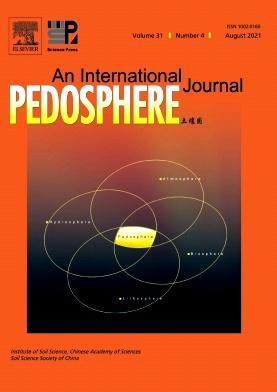水稻土壤的生物固氮是由多种土壤因子驱动的,速效磷是其中最大的贡献者
IF 7.3
2区 农林科学
Q1 SOIL SCIENCE
引用次数: 0
摘要
生物固氮对水稻的可持续栽培具有重要意义。不同的土壤因子对水稻土BNF的影响分别进行了评价。然而,没有一个单一的因素可以完全解释不同的土壤结果。稻田生物多样性更可能同时受到多种土壤因子组合的不同程度影响;然而,多种土壤因子相互作用对水稻土BNF调控的相对重要性尚不清楚。在西南和东北主要水稻种植区采集了27个不同土壤性质的水稻土样品,以确定影响水稻BNF量的土壤因子。水稻移栽到充满水稻土的花盆中,在富含15n2的密闭室中生长。BNF的估算基于水稻土壤和水稻植株在77 d孵育期结束时15N富集量的测量。土壤BNF含量变化范围为0.66 ~ 12.3 kg ha-1,与有效磷(AP)呈显著正相关,与有效钼(AMo)和总氮(TN)呈显著二次相关。有效磷解释了观测到的BNF变化的42%,TN解释了17%,AMo解释了13%。土壤阳离子交换量与土壤有效氮(由水稻氮素吸收决定)之间的特定相互作用占土壤氮素变化的28%。AP = lt时,BNF量减少;14 mg kg-1, AMo <;0.09 mg kg-1, TN = >;3.2 g kg-1。这些结果可为指导农民管理水稻土提供有价值的基准,以提高水稻BNF对土壤肥力的潜在贡献。本文章由计算机程序翻译,如有差异,请以英文原文为准。
Biological nitrogen fixation in paddy soils is driven by multiple edaphic factors and available phosphorus is the greatest contributor
Biological nitrogen (N) fixation (BNF) is important for sustainable rice cultivation. Various edaphic factors have been individually evaluated for their effects on BNF in paddy soils. However, no single factor could fully explain the different soil outcomes. Paddy BNF is more likely to be simultaneously influenced to various degrees by combinations of several edaphic factors; however, the relative importance of the interaction of multiple edaphic factors on the regulation of BNF in paddy soils is still unclear. Twenty-seven paddy soil samples with different soil properties were collected from the major rice cropping areas in Southwest and Northeast China to determine the edaphic factors affecting paddy BNF amount. Rice was transplanted into pots filled with paddy soils and grown in a 15N2-enriched airtight chamber. Estimation of BNF was based on the measurements of 15N enrichment in the paddy soils and rice plants at the end of a 77-d incubation period. The BNF amounts ranged from 0.66 to 12.3 kg ha-1, with a significant positive relationship with available phosphorus (AP) and significant quadratic relationships with available molybdenum (AMo) and total N (TN). Available P explained 42% of the observed variation in BNF, TN explained 17%, and AMo explained 13%. The specific interaction between soil cation exchange capacity and available soil N (as determined by rice N uptake) accounted for 28% of the variation in BNF. The BNF amount was decreased when AP was < 14 mg kg-1, AMo < 0.09 mg kg-1, or TN was > 3.2 g kg-1. These results provide valuable benchmarks that could be used to guide farmers in managing paddy soils to improve the potential contribution of paddy BNF to soil fertility.
求助全文
通过发布文献求助,成功后即可免费获取论文全文。
去求助
来源期刊

Pedosphere
环境科学-土壤科学
CiteScore
11.70
自引率
1.80%
发文量
147
审稿时长
5.0 months
期刊介绍:
PEDOSPHERE—a peer-reviewed international journal published bimonthly in English—welcomes submissions from scientists around the world under a broad scope of topics relevant to timely, high quality original research findings, especially up-to-date achievements and advances in the entire field of soil science studies dealing with environmental science, ecology, agriculture, bioscience, geoscience, forestry, etc. It publishes mainly original research articles as well as some reviews, mini reviews, short communications and special issues.
 求助内容:
求助内容: 应助结果提醒方式:
应助结果提醒方式:


